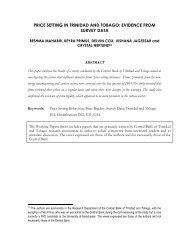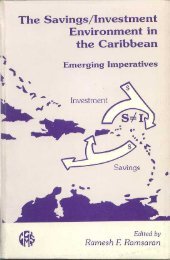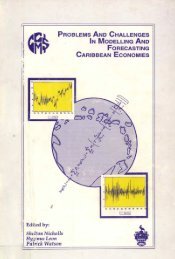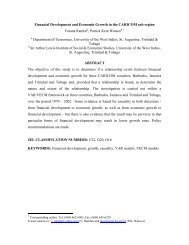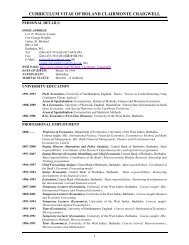The Observed Effects of Money Laundering for Jamaica - Caribbean ...
The Observed Effects of Money Laundering for Jamaica - Caribbean ...
The Observed Effects of Money Laundering for Jamaica - Caribbean ...
You also want an ePaper? Increase the reach of your titles
YUMPU automatically turns print PDFs into web optimized ePapers that Google loves.
All other variables are consistent with economic theory. <strong>The</strong><br />
positive relationship with Treasury bill rates and money demand can<br />
be as a result <strong>of</strong> the structural adjustment programs which had a an<br />
effect on money demand.<br />
<strong>The</strong> positive relationship between Treasury bill rates and money<br />
demand was explained by Atkin (2005) as it may be<br />
“A data problem: in the context <strong>of</strong> a shallow financial system the<br />
Treasury bill rate and deposit rate move together (Correlation: 0.9 <strong>for</strong><br />
<strong>Jamaica</strong>n rates). In this context it is possible that the treasury bill rate is<br />
proxying <strong>for</strong> ‘own rate’ rather than opportunity cost (Crockett & Evans,<br />
1980). Alternatively it may reflect problems associated with risk since<br />
the measured interest is not a risk adjusted rate. Unaccounted risk<br />
aspects could relate to inflation and institutional insolvencies, both <strong>of</strong><br />
which increased in the financial crises <strong>of</strong> the early 1990s, and coincided<br />
with the much greater interest rate variability resulting from financial<br />
liberalisation. <strong>The</strong> consequence may be that adjustments in the reported<br />
rate have not accurately captured the relevant underlying risk adjusted<br />
rate. In practice the liberalisation <strong>of</strong> the 1990’s was associated with<br />
higher real interest rates, financial deepening and a greater holding <strong>of</strong><br />
money. Thus the interest rate may be acting as a proxy <strong>for</strong> liberalisation.<br />
<strong>The</strong> significant and positive trend suggests increased monetisation <strong>of</strong> the<br />
economy over time”<br />
Our variable <strong>of</strong> interest which is the proxy <strong>for</strong> money laundering<br />
indicates a positive and significant relationship between <strong>Money</strong><br />
demand and money laundering in the long run. This indicates that an<br />
increase in money laundering by 1% increases the money demand by<br />
0.01%. This result implies that money laundering activities does have<br />
an impact on money demand. This can be as a result that money<br />
laundering activities are taking place through the banking sector <strong>of</strong><br />
42



